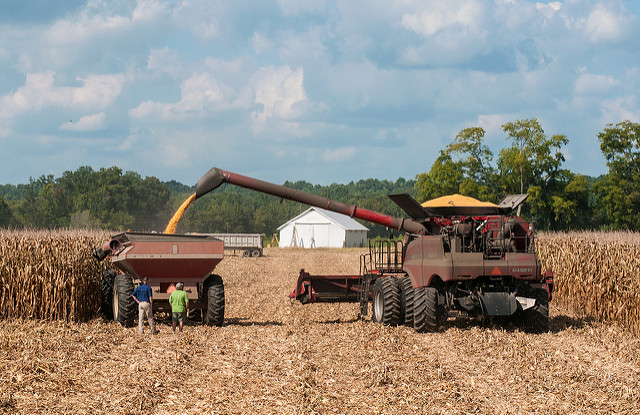
This is the second post in a multi-part blog series analyzing the draft farm bill released on April 12, 2018 by House Agriculture Committee Chairman Mike Conaway (R-TX). Other posts in this series focus on: beginning and socially disadvantaged farmers, local/regional food systems and rural development, research and seed breeding, conservation, and organic agriculture. The bill is expected to be considered and “marked-up” (aka amended) by the full Agriculture Committee this week and on the House floor in May.
Federal crop insurance and commodity subsidy support programs make up a significant portion of the federal farm bill – for instance, in fiscal year 2018 they are projected to make up roughly 75 percent ($17 billion) of the farm program portion of the bill. These programs represent a very important part of the farm safety net, however, their sheer size (not to mention significant vested interest in the status quo) has made making desperately needed program modernizations a bit like trying to turn around the Titanic.
The National Sustainable Agriculture Coalition (NSAC), along with our many members, partners and allies, have put forward many thoughtful recommendations on how these farm safety net programs could be retained and strengthened, while also making much-needed improvements that would increase program access, equity, environmental improvement, and accountability. Unfortunately, the Chairman’s draft bill fails to take advantage of this rare opportunity to turn the ship and modernize these important programs.
Among the crop insurance modernization proposals endorsed by NSAC, the Chairman’s mark only includes one modest change. Sadly, it completely ignores the asks of countless farmers and farm advocacy organizations to improve program access and equity, and to ensure that the federal crop insurance program encourages – rather than penalizes – farmers for stewardship efforts like cover cropping.
On commodity subsidies, the Chairman’s draft rolls out the red carpet for large corporations and mega farms by striking the prohibition on corporations receiving multiple payment limits (which has been in place for more than 30 years), allowing them to receive unlimited commodity subsidies. Another egregious handout to mega farms in the bill is a provision to allow additional categories of persons to be considered as “family members” for the purpose of increasing government payments, enabling large general partnerships to reorganize by making all the relatives of an extended family partners eligible for additional payments, thereby escaping even the very modest reforms included in the 2014 Farm Bill. If that were not enough, the bill removes any limitation at all on marketing loan payments.
Below, we include a summary of the key takeaways on how the Chairman’s mark approached crop insurance and commodity subsidy programs.
Highlights
- Extends crop insurance discounts for beginning farmers with Whole-Farm Revenue Protection policies by changing the definition of beginning farmers for this purpose from up to five years in business to up to ten years in business, consistent with all the other USDA beginning farmer provisions. This change provides much-needed additional coverage support for beginning farmers using Whole-Farm, because the program already requires users to have three years of revenue history before they can even purchase the policy.
Mixed Bag
- Reauthorizes buy-up for the Non-insured Disaster Assistance Program (NAP), without which the expansion of NAP that has occurred since the last farm bill would stall. However, the bill fails to include the innovative proposal within the Beginning Farmer and Rancher Opportunity Act that would make it easier for new farmers to access revenue-based crop insurance policies.
- Fails to expand Sodsaver to the entire country, though the bill retains the program’s existing service in the “Prairie Pothole” region of the upper-Midwest. Without this expansion, millions of acres of native sod outside this region will be at risk.
Lowlights
- Eliminates the Risk Management Education Partnership program, which last year provided awarded 76 organizations with partnership agreements to educate farmers on how to mitigate production, financial, and other forms of risk on their farms. This program is particularly critical for educating farmers on the relatively new Whole-Farm Revenue Protection policy, which is targeted toward beginning, diversified, organic, and other producer groups currently underserved by the federal crop insurance program.
- Requires the U.S. Department of Agriculture (USDA) to undertake a rulemaking to create regional exemptions for wetland compliance, claiming that elaboration is needed to determine the real world impact of the exemptions. This will inevitably weaken wetland protection and put taxpayers back in the position of paying for wetlands destruction.
- Fails to remove barriers to conservation and stewardship activities within the federal crop insurance program that discourage farmers from engaging in conservation practices such as cover cropping by threatening penalties or the voiding of coverage.
- Gives handouts to corporations and mega-farms by throwing out a 30-year old rule preventing corporations from receiving unlimited commodity payments; also includes provisions to eliminate limits on Loan Deficiency Payments and Marketing Loan Gains. As a further favor to large corporations, the bill also loosens the definition of family so that cousins, nieces and nephews can be added as passive farm managers, thereby increasing farm subsidy payments to a single farm by hundreds of thousands of dollars a year.


The removal of provisions limiting corporate farms to a single payment limit in commodity, loan deficiency and marketing loan programs is perhaps the worst and most regressive measures in this draft Farm Bill, worthy of united opposition by all family farming and rural community advocates.
And, given the strong Republican commitment to avoiding wasteful government spending, the elimination of the Risk Management Education Partnership Program leaves me utterly flummoxed. Isn’t training farmers to avoid or reduce risks in the first place (through better crop, soil, water, marketing and business management) the best way to save $ on crop insurance subsidy programs? Resilient farms mean less indemnity payments.